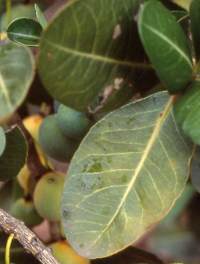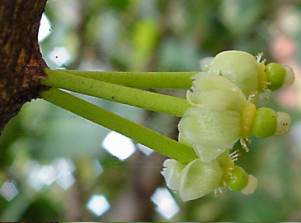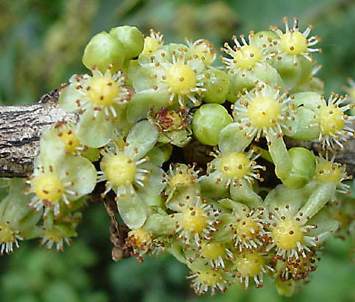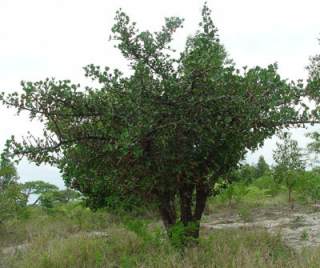Garcinia livingstonei
Garcinia livingstonei T.Anderson
Family: Clusiaceae
Common names: African mangosteen (Eng.); Afrika-geelmelkhout (Afr.); umPhimbi, uGobandlovu (isiZulu); mmimbi (xiTsonga); mokongono, mokononga (siPedi)
SA Tree No: 486
Introduction
From time to time one reads of individualists doing strange things and calling it 'living art'. Here is a tree which produces very tasty fruit, and whose form very definitely brings it into the realm of living sculpture.

Description
Description
Garcinia livingstonei is a small tree reaching 18 m in East Africa, pyramidal when young but later spreading, with thick, woody young branches and yellow to red resin. Leaves usually 3 in a whorl (may be 4 or opposite), variable in shape but usually egg- or lance-shaped, generally 60-110 × 30-55 mm, blue-green with whitish veins, waxy. Flowers in groups of 5-15 in leaf axils on old wood, greenish, whitish or yellow, scented, male and bisexual flowers of different structure. Fruit an orange berry, 10-40 mm in diameter, with yellowish orange, sticky juice.
Conservation Status
Status
Garcinia livingstonei is common, very widespread and not under any listed threat.
Distribution and habitat
Distribution description
The African mangosteen is widespread in the warmer parts of Africa, from just north of Durban as far as Somalia and Guinea. In southern Africa it spreads quite far up the Limpopo and Zambezi Valleys. In this range it encounters widely varying rainfall (from about 200 to 1000 mm a year) and soil types. However, the temperature is a unifying feature: winters (as far as they exist) are warm and summers are hot to very hot. These trees are notably sensitive to cold, though quite hardy to both drought and heavy rain.
Derivation of name and historical aspects
History
The genus Garcinia includes some 200, mainly Asian species (Mabberley 2002). The name commemorates one Laurent Garcin (1683-1751), a French botanist who was active in India, where the genus is particularly diverse (Glen 2003). The specific epithet honours the great explorer David Livingstone (1813-1873), who made one of the first records of the tree.
In India and the Far East, some dozens of species of Garcinia supply a wide variety of useful and even necessary items. One, G. mangostana (the true mangosteen) is so important that it is known, if subconsciously, to all children brought up on Kipling's Just so stories ; the verse accompanying the story of Pau Amma the crab depends on knowing what mangosteens are and where they grow. ('Ocean-going P&O's / pass Pau Amma's castle close . You'll know what my riddle means / when you've eaten mangosteens.') Mabberley lists three other Asian species with edible fruits. At least two other species, G. cambogia and G. indica provide flavourings for curries; the latter is also the source of the edible fat called Goa butter. G. xanthochymus and other species yield the resins that are processed into the artists' pigment Gamboge Yellow; the same pigment is also used in dyeing Buddhist priests' robes. Curiously, the resident fruit bats in Durban Botanical Garden seem not to eat the fruits of this tree, though they make heavy use of everything else that is edible. G. mannii is used in Cameroon for chewing sticks.
The only other species indigenous to South Africa is Garcinia gerrardii, which has emerald green, opposite leaves, not blue-green leaves in whorls of 3 or 4.
Ecology
Ecology
The flowers are full of nectar, which attracts many kinds of insects that pollinate them. The delicious fruits are sought after by animals, which disperse the seeds. The seeds, in turn, are enclosed in a hard coat, well suited to protecting the delicate embryo on its journey through the digestive system of the animal that ate the fruit.
Uses
Use
Mangosteens are known for their delicious fruits, and the African mangosteen is no exception to this. Despite the sticky yellow juice, the fruits of this tree are well worth seeking out. The tree is used in traditional medicine, and in particular the powdered root is used as an aphrodisiac. Coates Palgrave (2002) reports that the fruits can be fermented into a 'pleasant alcoholic beverage'; almost any book on English country wines will give half-a-dozen recipes which could be adapted to make use of these fruits. The wood is susceptible to borers, but has been used as a general-purpose timber.

Growing Garcinia livingstonei
Grow
The African mangosteen easily earns a place in any warm, subtropical garden. The form of the tree resembles a piece of angular modern sculpture, and the leaves and young branches are an almost unique shade of deep blue-green. The fruits are memorably delightful, and no doubt will cause intense competition between gardeners, neighbours birds and monkeys-indeed, anyone who knows good eating!
These trees grow slowly, and so remain manageable in small gardens for a long time. They do better on deep, sandy soils, such as the semi-fossil beach dune on which most of Maputo is built, but will grow (after a fashion) elsewhere. In my own garden, I planted one about two years ago close to a sandstone outcrop. The tree is growing, but seems set to become an inadvertent bonsai. Maybe bonsai enthusiasts could experiment with African mangosteens, though I doubt whether they would grow into any recognized style.
The fact that African mangosteens appear regularly on the Botanical Society plant sale in Durban indicates that they are available as small trees from nurseries, at least in this area. Although it may be harder and possibly less legal to find seeds than nursery-grown plants, Pooley (1993) tells us that these trees can easily be grown from seed. Not surprisingly, they are known to be sensitive to cold.
Almost any tree can be given a good start if you plant it the way the late Denzil Carr of the Tree Society taught me. The hole needs to be at least a metre cube (two metres long is better, he said). Put a layer of broken bricks, the cheapest and nastiest stock bricks you can find (rubble from a demolished wall is often ideal) in the bottom, and a pipe (a used gutter or down-pipe) in one corner. Put a rich mixture of topsoil, compost and a little fertilizer on top of the bricks, and back-fill the hole so that the poorest soil is on top. Now put the hose down the pipe and water the hole until the top of the soil is saturated. By doing this, you will have filled the bricks and the good soil with water, which they will release slowly. When the top subsides, an hour or so after this soaking, you can plant your tree, and make good the subsidence in the hole with more subsoil or any other mulch. Water the tree thoroughly from below via the pipe once a week. This will cause the roots to grow downwards, so that the soil acts as a mulch. Despite appearances, this actually saves water, as well as encouraging the tree to grow faster than it would otherwise.
Once it is established, the African mangosteen will need almost no maintenance. I do not recall ever seeing a diseased one, and certainly mine is not attacked by the legions of caterpillars and other herbivores in my garden. At the time I took the picture of the fruit attached to this page, at Universidade Eduardo Mondlane in Maputo, the only pest attacking the fruit was myself. However, any garden centre should be able to advise on prevention if there is an outbreak of insect pests.
References
- Balkwill, K., Boon, R., Coates Palgrave, M., Glen, H., Jordaan, M., Lötter, M. Schmidt, E. & Thomas, V. 2004. SAPPI Tree spotting lifer list. Jacana, Johannesburg.
- Bamps, P., Robson, N. & Verdcourt, B. 1978. Flora of tropical East Africa: Guttiferae. Crown Agents, London.
- Coates Palgrave, M. 2002. Keith Coates Palgrave Trees of southern Africa, edn 3. Struik, Cape Town.
- Glen, H.F. 2004. SAPPI What's in a name? Jacana, Johannesburg.
- Killick, D.J.B. & Robson, N.K.B. 1976. Clusiaceae. Flora of southern Africa 22: 14-23. Botanical Research Institute, Pretoria.
- Mabberley, D.J. 2002. The plant-book. Cambridge University Press, Cambridge.
- Pooley, E.S. 1993. The complete field guide to trees of Natal, Zululand and Transkei. Natal Flora Publications Trust, Durban.
- Von Breitenbach, F. 1965. The indigenous trees of southern Africa. Government Printer, Pretoria.
Credits
H.F. Glen
KwaZulu-Natal Herbarium, Durban
April 2007
Plant Attributes:
Plant Type: Tree
SA Distribution: KwaZulu-Natal, Limpopo, Mpumalanga
Soil type: Sandy, Loam
Flowering season: Spring
PH: Neutral
Flower colour: Green, Yellow
Aspect: Full Sun, Morning Sun (Semi Shade)
Gardening skill: Easy
Special Features:
Horticultural zones












Rate this article
Article well written and informative
Rate this plant
Is this an interesting plant?
Login to add your Comment
Back to topNot registered yet? Click here to register.